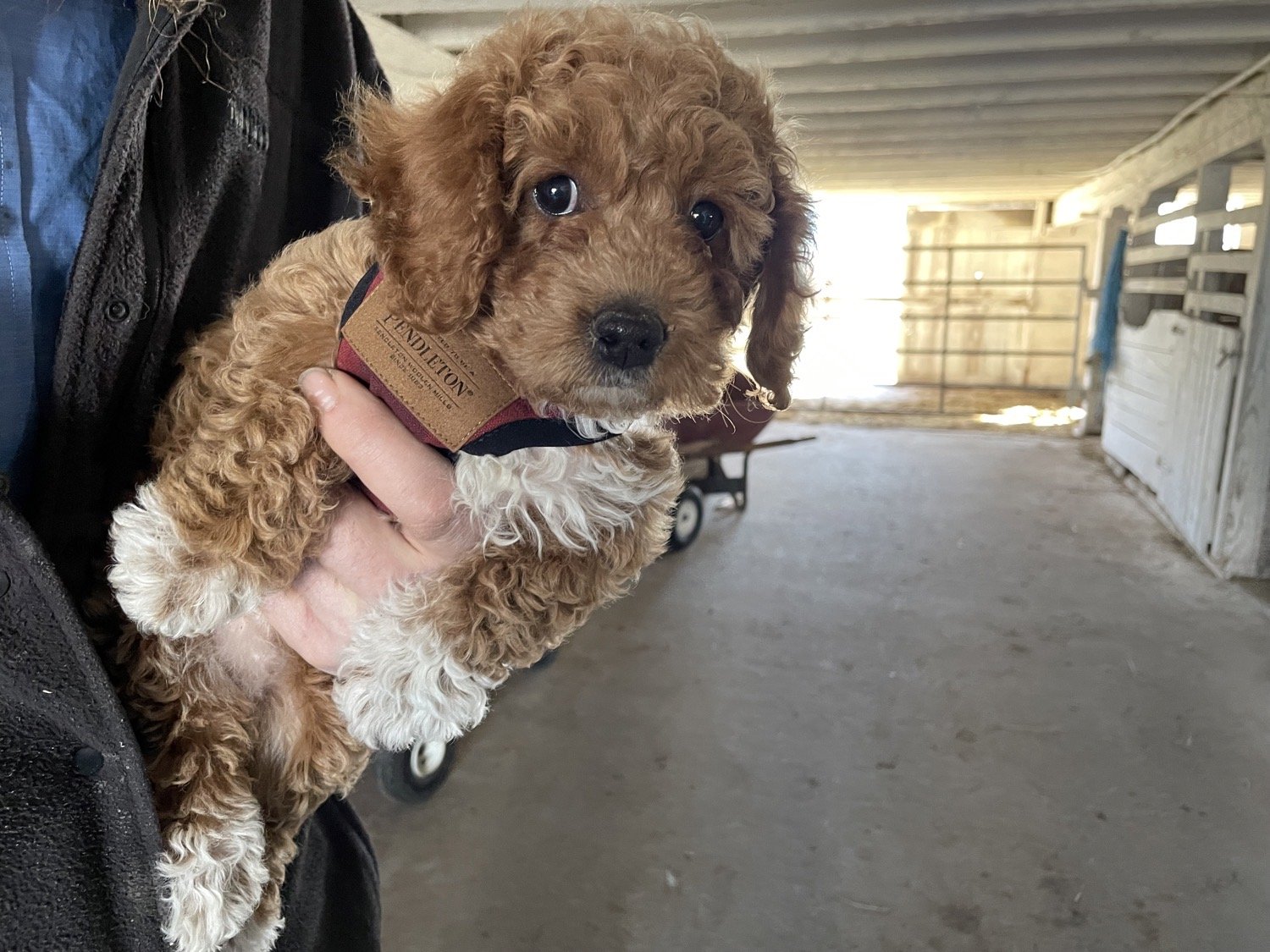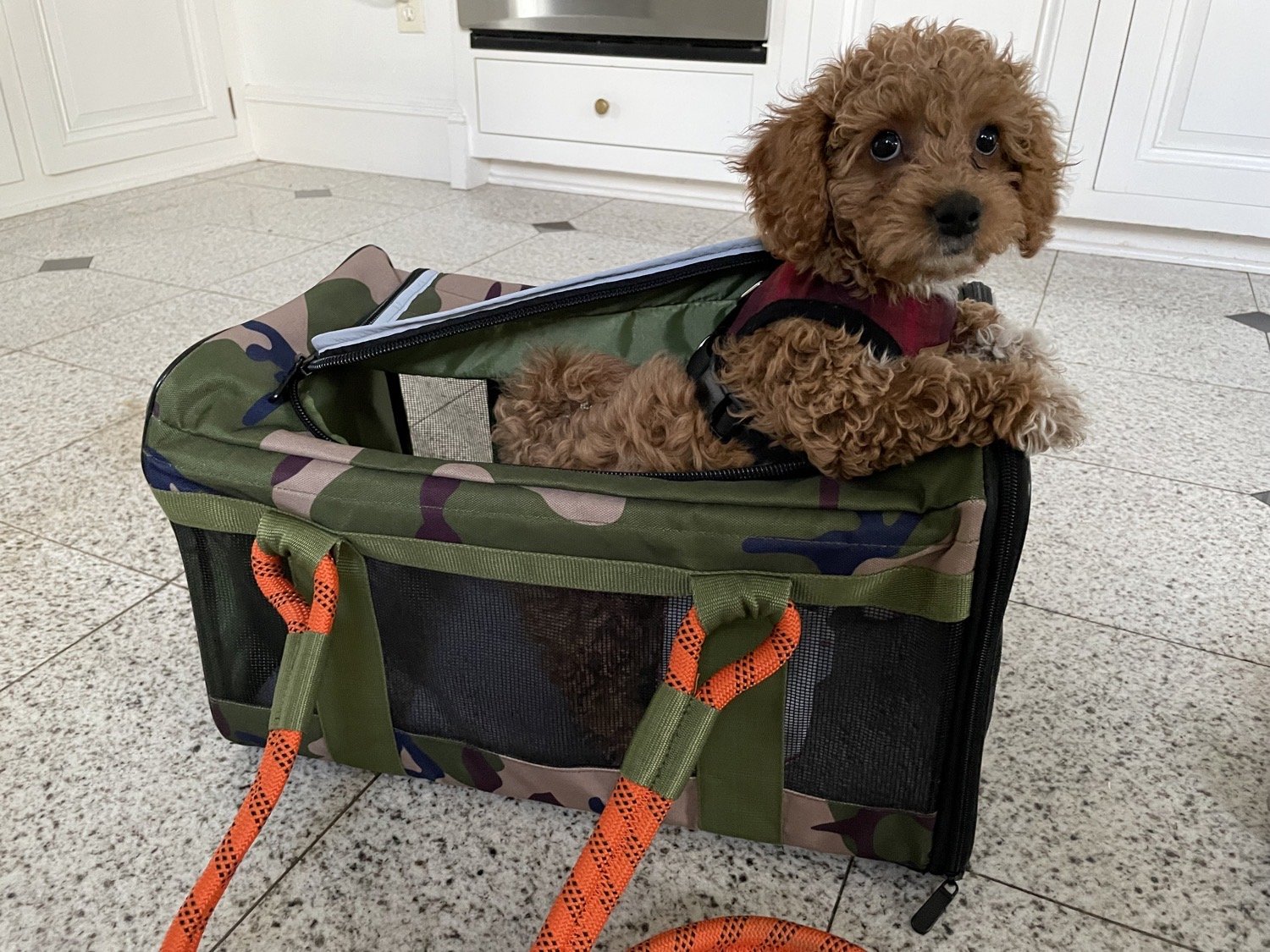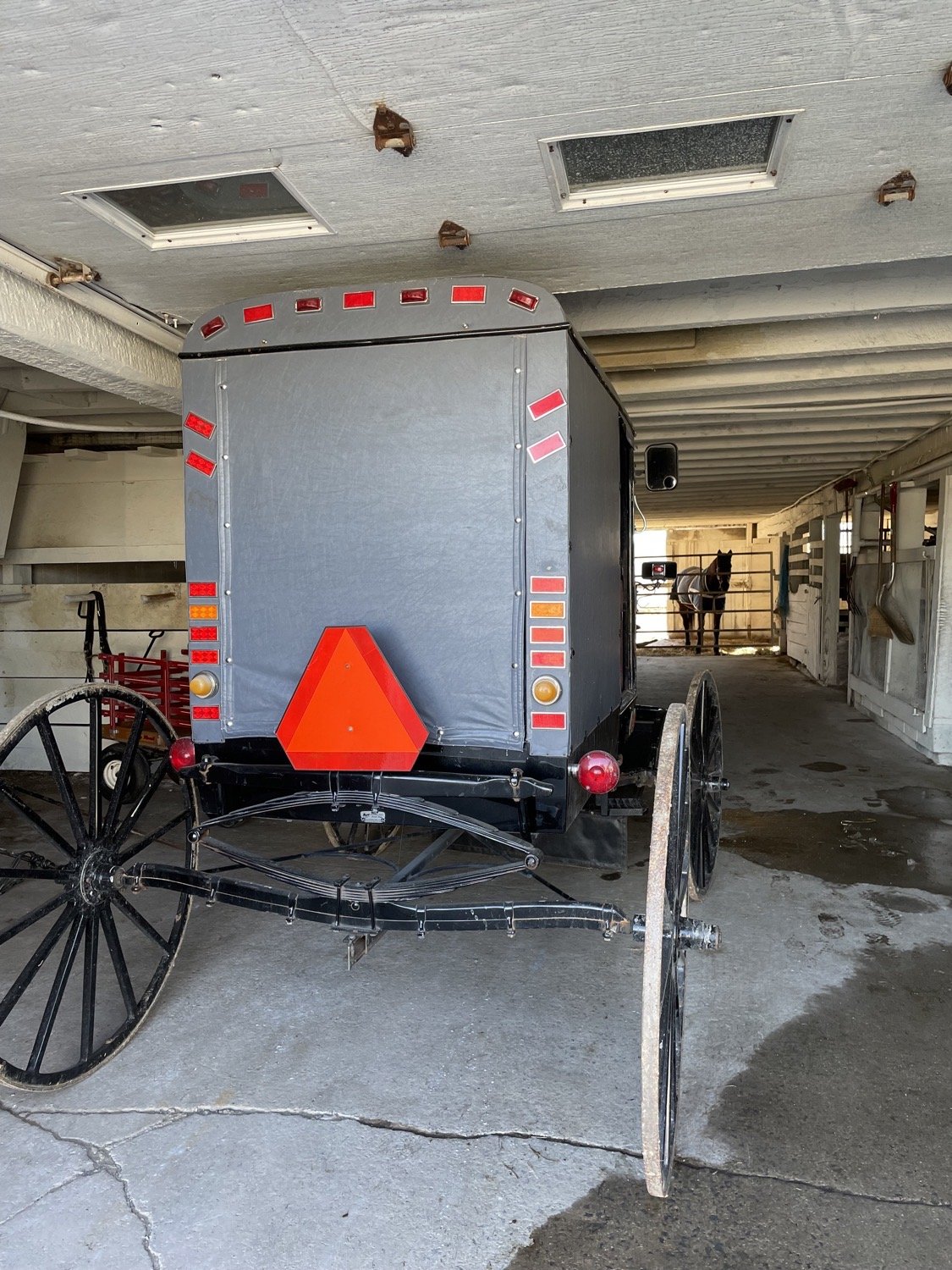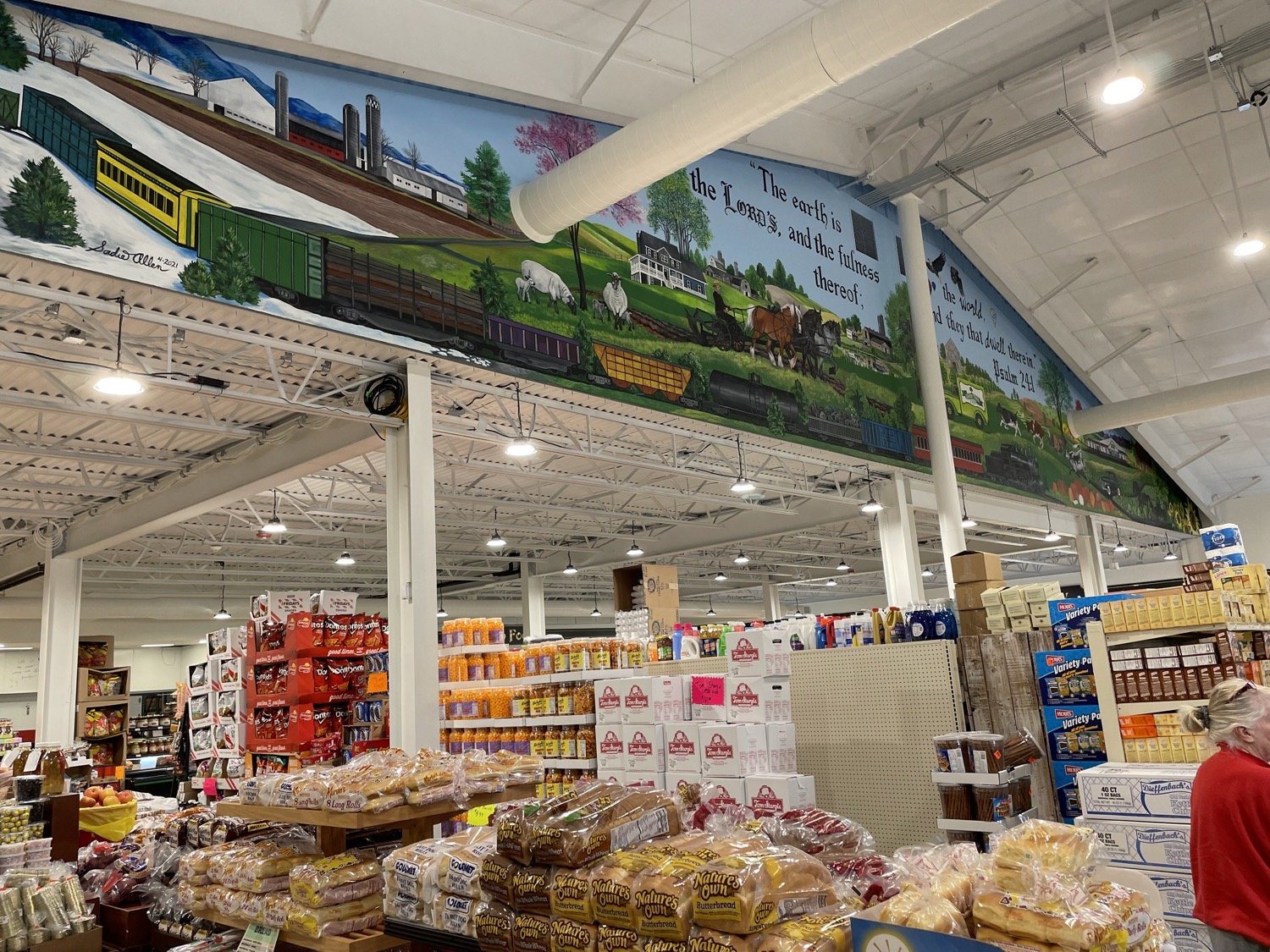Adopting A Doodle Puppy From Amish Country’s Epicenter of Dog Breeding
Molly at home in Amish Country
QUARRYVILLE, Pa.— As we drove the undulating hills of eastern Pennsylvania, we began to see muscled horses trotting in farmyards, monochrome dresses fluttering from clotheslines and spirited children playing tag outside small country schools.
Our journey to Old Amish country was for business, not pleasure. When you think of Amish country industry, one conjures oak furniture, quilts and perhaps farm stands. Few may realize that the Amish also flourish when it comes to breeding puppies.
Like many people seeking special companions in the Northeast and Midwest regions of the United States, we drove hours, invested hundreds of dollars and loads of emotional energy into this pilgrimage to a unique religious and cultural landscape. We’d come to adopt a five-pound, brown, furry little friend. She was an Amish-born canine Doodle princess. Her given name: Alisha.
“Ooohhh! I can’t believe we are finally getting a DOG!” my daughters exclaimed repeatedly on the journey, a road trip seared in their memories perhaps forever.
Molly’s online marketplace photo, which melted hearts.
Dreams of a Dog Deferred
For years, my 10-year-old asked to get a dog. We spent hundreds of hours discussing the idea, researching breeds and considering when and how to obtain a canine companion. We tried visiting local animal shelters and discovered a majority to be fearsome pit bulls, a breed our entire family dislikes. I tried using the popular site Petfinder to locate rescue dogs and found few available after several wild goose chases. That app would often shuttle me to animal shelters in other states, and dogs we pursued were already adopted. The Petfinder site also seemed slow to update and clunky to use.
We decided we wanted a small puppy that wouldn’t knock over grandparents on walks and would be easy to travel with on flights or road trips. And, yes, we joined the legions of people pursuing poodle mixes, often called “Doodles,” which are rapidly rising the leaderboards of dog breeds much to the chagrin of some other dog owners according to a recent story in The Wall Street Journal. Doodles are often intelligent, good natured and hypoallergenic. German Shepherds and Pit Bulls be damned. Golden Retrievers and Labradors? Watch out. Doodle popularity is coming to dethrone your breed next.
We almost obtained a cocker spaniel-poodle mix, or cockapoo, puppy in New Jersey for $2,400 in December, but travel plans didn’t line up for us to adopt. Plus, the breeder wasn’t super communicative. Meanwhile, we heard positive things from people who found pets from the Amish in Pennsylvania.
One weekend in January, I restarted the search for a puppy and came across the Lancaster Puppies website, downloading the iOS app. Searching “cockapoos” in New Jersey, I saw only one animal available. When I changed the filter to Pennsylvania, more than 100 cockapoos surfaced. My daughter and I compared favorites, and we both rapidly concluded that a brown-and-white cockapoo named Alisha was the most adorable we’d seen. A photo of her doggie head tilt and soulful expression elicited an involuntary, “Ooohhhh! I Love HER!” from my daughter, who also suggested the white fur on her chest resembled a sign of the cross. We nicknamed her “Orthodog” and “Orthodoodle.”
A chalkboard in the photo behind Alisha carried the message, “This is the day the Lord has made. Let us rejoice and be glad in it.” Alisha was listed for only $1,100, less than half the price of the cockapoo I almost purchased in New Jersey. And she was located in Quarryville, Pa., which is in Lancaster in the heart of Amish country. The description on the profile of Alisha explained her heritage — daughter of a cockapoo mother named Roxy and a toy poodle stud (a seeming misnomer)— and other details. “Call Ester Stoltzfus today to learn more about the puppy of your dreams!”
I called the number on a Sunday evening and left a message for Esther and Isaac. Their voice mail said they would return calls on Monday. My daughter prayed that night that we could adopt Alisha and peppered me with questions nonstop. “Will we get the dog?” “Did you hear back yet?” “Can we adopt Alisha?”
The next morning, Esther called. With a cheery voice, she said we were first in line to adopt Alisha and we were lucky to have called the day they listed the puppies — before many other people called about Alisha and her two siblings. Esther noted we needed to make a deposit and gave details to send $200 to their friend who used Zelle for payments. I realized this must be because the Amish don’t use such technology. Before I could send the money, Esther called back to say their friend couldn’t use Zelle because of fees.
Molly enjoys cuddlng with people and in peoples’ coats
Molly adjusted well to her new home in New Jersey.
Molly enjoyed her new luxurious furniture.
We made plans to mail a check. My family also tried to adopt Alisha’s sister, Ashley, so they could be playmates and to keep family together. It was too late. Another woman was in line to adopt Ashley. Esther told me this customer asked if this was “a scam” and demanded videos or Facetime evidence that everything was legit. I noticed Esther’s puppy profiles on Lancaster Puppies soon featured a short video of the three adorable puppies running in a lush green yard with a woman, presumably Esther, wearing a navy dress running alongside. I figured this was the “proof of normalcy” video the woman demanded and served as indication that this was a nice Amish family. My daughters felt the woman was rude to Esther and expressed their disgust multiple times, also hoping she would drop out of contention for the second puppy — to no avail.
Later, Esther gave me details for a new friend who could receive a Zelle payment. I asked this woman, Lauren, about the puppy industry in Amish country. Since Amish people don’t believe in using technology such as computers, email or the internet, Lauren said they pay fees for people to take photos and list profiles of their puppies. My conversation with Lauren also confirmed that Esther and her family were legitimate.
“We don’t use the internet — we don’t have computers,” Esther explained to me at one point. People from websites such as Lancaster Puppies “come out and take pictures for us and put them on the site. All we do is show the puppies and give them our information and then you can call. It’s really nice.”
Amish Puppy Mill Panic
Around this time, I started googling information about the dog breeding industry in Lancaster County and quickly came across sites such as Stop Online Puppy Mills, the Puppy Mill Project and Animal Advocates SCPA that give warnings about Amish participation in dog breeding. It was clear that some animal rights activists despise the Amish dog breeding industry. I believed we had a great dog and breeder, but I did want to make sure we weren’t supporting puppy mills.
“Almost every Amish community has puppy mills,” said a post from Stop Online Puppy Mills dated Oct. 4. “Some Amish communities focus on dog breeding while others have puppy mills/farms scattered within them. Sadly, dogs are considered livestock, a cash crop and just another source of lucrative income for the Amish.”
This website said Lancaster County, Pennsylvania, is the epicenter of the Amish puppy breeding industrial complex. It said Amish and Mennonite dog breeding also happens in Holmes County, Ohio, Shipshewana, Ind., and other counties with a high concentration of Amish people. It said the communities often sell their dogs directly to the public through Lancaster Puppies, Greenfield Puppies or a mix of online classified sites such as Puppy Find.
Exposes on major broadcasters such as ABC News in the past 20 years have explored the booming Amish dog breeding industry, in which some breeders who keep dozens of dogs can easily make more than $100,000 per year. The videos explored practices such as “debarking” procedures that render dogs unable to bark or make noise in barns. One video suggested some Amish breeders perform cesarean sections and other procedures on dogs rather than hiring a veterinarian to do so. They also quoted Amish dog breeders saying they don’t let dogs outside. Some sites made undercover videos that aim to expose inhumane treatment, showing dogs in cages without proper medical treatment.
One site reported that according to USDA licenses, more than 98% of Ohio’s puppy mills are run by the Amish, as are 97% of Indiana’s and 63% of Pennsylvania’s. The fact-checking site Snopes had a post checking the claim from a 2017 meme that the Amish owned 20% of the nation’s puppy mills. Snopes concluded that the statistic cannot be proven and that many commercial breeding kennels in Lancaster had closed.
A search of news stories about Amish “puppy mills” yields a host of stories about increased regulation. In Iowa, a problematic breeder was fined $20,000 in October according to the Iowa Capital Dispatch. Another story from Ohio’s WKYC highlighted 16 puppy mills in the state that were listed on the Humane Society’s “horrible hundred” list. Other sites say some Amish puppy mills house dozens or hundreds of dogs in pole barns or outbuildings, where dogs live in overcrowded, stacked cages. They allege that the dogs are force-bred at every heat cycle. They say veterinarian care is minimal because it costs money. One site said, “It is so important to see for yourself where your puppy was born.”
Almost immediately, I started sleuthing around the Lancaster Puppies app to determine if Esther and Isaac were running a puppy mill or if they were a smaller family puppy breeding operation. I filtered all puppies on the app from Quarryville and did a series of random checks to see how many puppies Esther and Isaac listed. I saw only two small batches of puppies, which made me feel good. I noticed some other sellers have many more batches for sale.
I appreciated how personable and honest Esther was on the phone. We talked about the puppy mills problem at one point, and she welcomed me to ask questions and write about this topic. She also welcomed our family to pick up the puppy and meet their family. To me, these were all good signs.
I also saw signs that parts of the Amish community were working toward better practices for puppy breeders. A 1993 story from The New York Times showed the Amish community was facing backlash and boycotts over its ambitious dog breeding goals and questionable methods three decades ago. A search on “Amish improve puppy business” indicated many Amish families and communities aim to improve their business practices and collective reputation. As bad press exposed the practices, regulations took effect in some locations, and some norms also changed as more Amish families saw dogs as pets rather than just livestock.
One story in Gannett newspapers in Indiana and Kentucky in 2016 reported how the Amish were aiming to restore their dog breeding reputation. It showed how some Amish breeders were talking to Purdue University’s Center for Animal Welfare Science to establish breeding practices that would make both consumers and dogs happy.
“A team of researchers started a pilot program to review how breeders run their facilities and whether certain changes could improve the physical and behavioral health of their dogs,” reported the Journal & Courier newspaper. Purdue researchers advised the breeders to let dogs run in the yard to exercise and socialize more and found the dogs looked and behaved better. The project aimed to develop certifications that would go beyond U.S. Department of Agriculture mandates on food, water, housing and climate.
"We’ve seen a very positive impact on some of the things she recommends," said Levi Graber, a member of the Odon, Ind., Amish community who works with dog breeders. "I've seen more contented, happy dogs." He told the reporter that breeders like him wanted to sell puppies that wouldn'’t disappoint anyone. He said he wanted to meet customer expectations and “not be a burden to anybody.”
Picking Up Alisha
A site called Amish America explains that alternative animal breeding is a way for Amish families to make money and a business that “fits” Amish culture and centers on rural life, agriculture and close connection with animals. The Amish have always used horses to pull their buggies and help with farm work, meaning horse breeding has always been part of Amish culture. And the site said some Amish people are active in the exotic animal trade, breeding parrots, zebras, foxes and hedgehogs. Perhaps Netflix will consider a series on Amish exotic breeders once it exhausts its appetite for portraying tiger breeders such as Joe Exotic and Carole Baskin?
Many people recognize Old Order Amish for their horse-drawn wagons and their 17th century appearance that includes mostly dark-colored clothing, beards for men, head coverings for women in public and a prohibition on zippers. Buttons? Those are fine.
“Will Alisha react to the internet, cell phones and computers in your home,” asked our friend Gerry from Long Island, joking that the dog may have Amish beliefs and practices. He wondered aloud if Alisha would be troubled riding in an automobile powered by an internal combustion engine rather than horses.
The Amish in America grew out of conservative Anabaptist communities that started in Switzerland in the 1600s. They follow the teachings of Jakob Ammann, who spearheaded a split with the Mennonites over the issue of excommunication. The Mennonites take a softer approach to excommunication.
As we arrived in Lancaster County, I felt refreshed. The clean air, rolling pastures and orderly, well-made buildings reminded me of bucolic countryside in Europe, such as in rural Germany or Switzerland, where the Amish originated. I also sensed a pleasant absence of marketing, technology and materialism. As we passed the schoolhouse, my 10-year-old daughter chimed in.
“Hey Dad, do you think this is where Pee Wee Herman made that balloon music for the Amish people?” she asked, referencing one of our favorite hilarious and heart-warming scenes from the 2016 film “Pee-Wee’s Big Holiday,” in which Paul Ruben’s character charms a group of Amish people by demonstrating the joy of making a balloon squeal as a source of fun — a low-tech activity that then caught on wildly with that community.
The Old Order Amish are known for being separate from the dominant society and cautious of technological innovations, according to Edsel Burdge, Jr., research associate at the Young Center for Anabaptist and Pietist Studies at Elizabethtown College. And they area growing in number.
In 2020, about 340,000 Old Order Amish resided in about 560 settlements in the United States. Another 6,000 live in Canada and about 200 live elsewhere. The birth rate for Old Order Amish is more than triple the U.S. birthrate. Many Amish families have 5, 10 or more children.
As we pulled up to the Stoltzfus’ house, Esther came outside with Alisha and my daughters went bonkers for their new pet. They scampered in the yard, playing and bonding with the tiny puppy while I chatted with Esther and Isaac. Their own house dog, an older Yorkshire Terrier, pranced around the yard.
They told me they first started owning and breeding Siberian Huskies, a favorite dog for Isaac, in the early 2000s. “It kind of went from there,” he said. Growing up, he saw puppies selling for as little as $5 through bulletin boards and classified ads. But around the millennium, demand for small dogs started to take off and so did Lancaster County’s reputation for breeding small dogs and harboring some puppy mills.
“People just started filling that demand as demand went up,” Isaac said. “When we started selling dogs, I thought selling a puppy for $300 was a nice, good amount you know. That was pretty decent pay.”
The Stoltzfus family said they sold only Siberian Huskies up until 2019 when they started to see more city dwellers coming to buy puppies and realized the Siberian Huskies might not be best geared for life in a small apartment. So they branched into smaller breeds “for people who want a dog inside the house.”
The Stoltzfus family expanded their operation, building a kennel that can hold about 10 mostly female dogs. If each female bears 3-7 puppies per year and those puppies sell for between $700 and $1,200, the Stoltzfus family likely earns somewhere between $21,000 and $84,000 in revenue each year from selling puppies.
The big boom for their business occurred as apps began making markets between breeders and buyers. “That’s when puppy selling really went up, once we started putting them on the Internet,” Esther explained. “Usually, we would have just listed them in the local papers. We didn’t have people from all over like we do now. Most people now are from out of state.”
And the Internet and App economy also brings outsiders and Amish families together more often. I mentioned I saw they had recently had clients from Brooklyn, Ohio and many other places.
“Oh Yeah! A lot of people are from New York, New Jersey and Maryland,” Esther explained.
From their perspective, Petfinder and other apps that connect stray dogs and rescued dogs to owners is a wonderful service. They also know America has more demand for pets beyond the stray and rescue market. And the demand is very helpful for Amish families, trying to sustain their family, their farm and their faithful way of life.
“The plain people aren’t doctors and lawyers, you know, so their jobs are not as high paying typically as people with high education,” Isaac said. “So they supplement their income with selling a few dogs.” They also enjoy sharing this side business with their children, who often play with the dogs and take them for walks on the farm.
Isaac and Esther said they are glad to see the awareness of puppy animal welfare growing in the area. A non-profit group called PAWS includes a large group of Amish men who work with animal welfare advocates to educate people about the law as well as how to have decent care for dogs. “They are trying to cut down on that puppy mill idea and get that out of Lancaster County,” Isaac said.
Isaac and Esther gave us a tour of their farm, including the workshop where Isaac and his children fashion beautiful, hardwood furniture with clean lines and, sometimes, a distressed farmhouse look. They showed us the barn where they keep their horse and buggy.
The author’s children visiting the dog breeding operation at an Amish farm.
Dogs at the Amish farm had access to the outdoors, heated and cooled kennels and lots of exercise and fresh air.
And they showed us their dog kennel with half a dozen Siberian Huskies on one side and half a dozen small dogs like Cocker Spaniels and Shih Tzus on the other side. Each dog had its own fenced in area and the ability to run through a pet door to an outside area. The dogs seemed happy, healthy and energetic. They barked and ran excitedly when seeing my children. I was glad to see the dogs also ran on safe, flat floors rather than on raised chicken wire platforms like animal rights videos showed of puppy mills. Esther pointed out an air conditioning machine that keeps the kennel cool in the summertime.
Our conversation was interrupted momentarily by my 5-year-old daughter running up and making an important announcement.
“We need some poop bags!” Emmy said. “Alisha’s making pooh!”
When that crisis was averted, I asked Isaac and Esther what advice they have for people buying puppies in Amish country. They seemed hesitant to respond as they don’t like to speak negatively of anyone. They suggested people do basic things like get in contact with sellers, make sure people are doing more with puppies than just giving basic food and water. They say to make sure that worming and vaccinations are up to date and certified by a veterinarian. They suggested being skeptical if people ask for deposits more than $200.
“I’m not a scam investigator so I probably can’t give you the best advice,” Isaac said. “It’s very sad and unfortunate that where there is a good demand for something, there will be scammers at work.”
As they ponder the question more, Isaac said you can see when a dog was socialized well. It interacts and doesn’t slink back into a corner. Esther and Isaac seem to worry they are sounding judgmental and perhaps don’t want to commit a sin of pride.
“We are not perfect. We make mistakes,” Esther said. “We have learned so much from puppies. You would think we know how to do it. But we keep learning.” My mother-in-law, who traveled with us, assured Esther that all humans make mistakes and that Esther is doing a good job.
As we walked around the farm, I enjoyed chatting with Isaac about growing up as the son of a Baptist pastor in South Dakota and the fact we are in different wings in the broader Christendom. Another enjoyable moment in our conversation was when I explained that I hoped the dog would help my kids stay off technology devices. “It’s a big problem for many families these days,” I said. “The technology is so addictive for kids.” Isaac heartily agreed. And, in that moment, I realized the Amish were prescient and inoculated from the plague of big technology companies that has wrought an explosion of addictive algorithms and legions of substandard of content.
At one point, I also brought up the animal rights argument that Amish, in their theology or cultural perspective, don’t see dogs as pets but, rather as livestock. I asked if that was true and if it is now changing.
“It is changing big time!” Isaac said. “There probably were kennels that operated like that” treating pets as livestock and just operating for the money. Now, they see more people caring about the puppies and realizing they are pets. They say the PAWS group has helped with that perspective shift.
“Socializing and love is the biggest thing,” Isaac said.
A horse and buggy the Stoltzfus family uses for transportation.
A coffee shop at a grocery store in Quarryville, Pa.
Driving home with Molly to New Jersey.
Alisha Moves to Jersey And Becomes “Molly”
We said goodbye, loaded Alisha into our SUV – she sat in her carrier between my two daughters – and set off on our journey back to New Jersey. I only made it a few miles before we encountered a marvelous Amish grocery store called Singing Spring Foods and the adjacent Crossroads Café. Several horses and buggies parked in the lot and I saw one older Amish man riding an electric wheelchair, causing me to wonder how he got special dispensation.
Inside the grocery store, a vaulted pantheon-style wall featured a large mural depicting lush Amish farms and a train passing through the bucolic scenes. The words from Psalm 24:1 are written across the sky in the mural: “The earth is the Lord’s, and the fulness thereof. The world and they that dwell therein.”
In Amish country, you see many positive message slogans painted on signs and placed on walls to telegraph optimism. Inside the Crossroads Café, I saw an amalgam of nine such signs fastened to the wall above a freezer that contained pints of ice cream and cold drinks. One sign said, “Change your thoughts, change your world.” Another said, “Always choose happiness.” Another said, “Today’s moments are tomorrow’s memories.” I imagined some Amish woman somewhere cranking out these signs as an optimistic sloganeer.
A cheerful mural with a religious message inside a grocery store in Quarryville, Pa.
At the Crossroads Café, I ordered ham sandwiches for my crew, delicious hot pretzels that reminded me of my time living in Germany and some delicious, iced Dutch coffees. Young Amish women work the kitchen and the cash register. As I walk out of the café, I see a pleasant and quirky-fonted sign above the EXIT sign: “May God Bless You on Your Journey.”
We made good time back to New Jersey. We’ve been in love with our puppy, integrating her into our multi-generational home. We voted at dinner one night on a new name with the winning nomination coming from my daughters and secured by persuasive speeches. The puppy is now named “Molly.” Not Molly of Denali but, rather Molly of New Jersey.
Esther called me a day later to see how the puppy was doing and to ask if I could send them a copy of the article when it is published. I said, yes, I can mail a copy. She suggested I could perhaps fax them a copy. I realized I don’t have a fax machine anymore, a rare zone where Amish-permitted technology trumps mine. Esther also asked if I could let them preview the article but said she understood if I can’t do so. I told her that, indeed, journalists don’t like to have sources pre-read articles. Such a practice would limit the integrity and independence of the author. I’m glad she understood. I’d asked to take photos of her and Isaac when I visited and they said they preferred not to be photographed. So I respected their wishes as well. I felt my life was enriched from my trip to Lancaster County and my time with them. I hope my family can visit again before long to see more of the landscape, culture and food.
Emmy and her new puppy, Molly.
So far, Molly’s adapting well to her new high-tech environment of motorized vehicles, a beeping fridge and Bluetooth-enabled music. She seems puzzled by cell phone cameras and tilts her head in a cute way when she hears music or videos. Her experience with the Stoltzfus family and her fellow dogs in the kennel prepared her to sleep well at night and to understand boundaries better than most puppies. She wakes up ready to play with kids in my house the same way she woke up ready to play with kids at the Stoltzfus house in Quarryville. And I think back on the words of Isaac:
“Socializing and love is the biggest thing.”
Paul Glader is executive editor at ReligionUnplugged.com and a professor of journalism at The King’s College in NYC, where he directs the McCandlish Phillips Journalism Institute. He spent 10 years as a staff writer at The Wall Street Journal and has also reported for The Washington Post, The Associated Press, Forbes.com and many other publications.
Positive messages inside the coffee shop and grocery store.
















